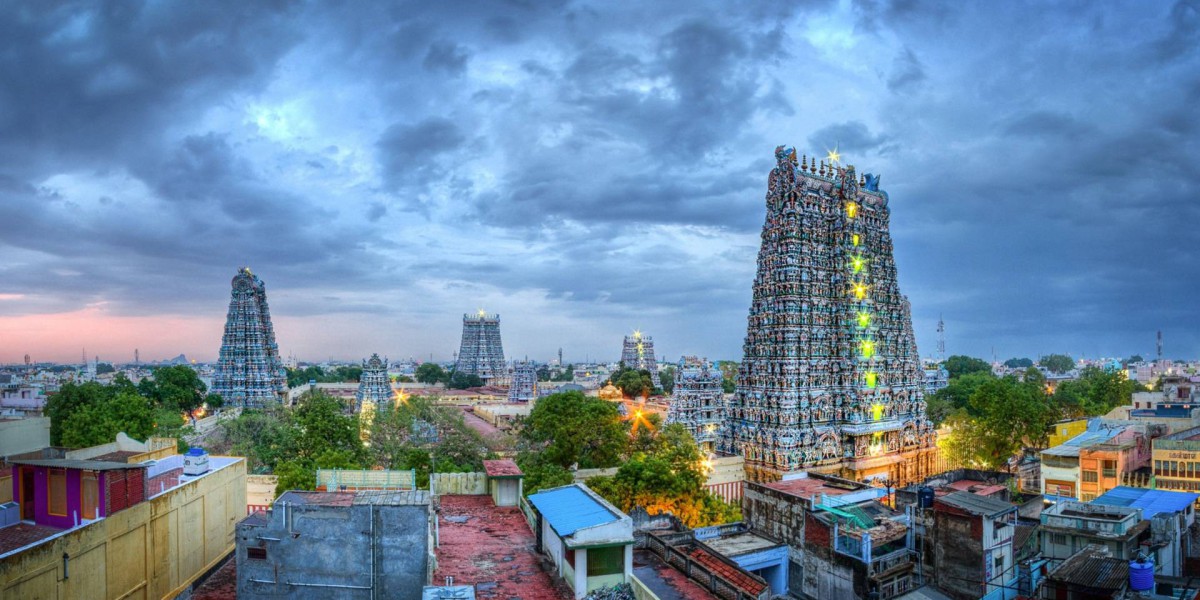Embarking on a temple tour across Madurai, Rameshwaram, and Kanyakumari is a journey steeped in history, spirituality, and cultural richness. These destinations in South India are renowned for their magnificent temples, each with its own unique charm and significance. This detailed guide will help you navigate the complexities of planning your tour, ensuring you experience the best of these sacred sites.
1. Overview of Destinations
Madurai: Often referred to as the "Athens of the East," Madurai is an ancient city with a rich cultural heritage. It is primarily known for the Meenakshi Amman Temple, an architectural marvel that attracts millions of pilgrims and tourists annually. The city’s vibrant bazaars, ancient temples, and historical sites provide a fascinating glimpse into South India's past.
Rameshwaram: Situated on Pamban Island, Rameshwaram is a crucial pilgrimage destination in Hinduism. It is part of the Char Dham Yatra, which includes Badrinath, Dwarka, and Jagannath Puri. The Ramanathaswamy Temple is the centerpiece of Rameshwaram, famous for its elaborate corridors and sacred wells. The town is also noted for its scenic beauty and proximity to the ghost town of Dhanushkodi.
Kanyakumari: The southernmost tip of India, Kanyakumari, is where the Indian Ocean, the Arabian Sea, and the Bay of Bengal converge. It is celebrated for its stunning coastal views, including sunrises and sunsets over the ocean. The Kanyakumari Temple, dedicated to the goddess Kanya Kumari, and the Vivekananda Rock Memorial are among the key attractions.
2. Crafting Your Itinerary
Day 1-2: Madurai
- Arrival in Madurai: Fly into Madurai or arrive by train/bus from major South Indian cities.
- Visit Meenakshi Amman Temple: Spend a significant portion of the day exploring this grand temple. Admire its intricate sculptures, massive towers, and vibrant color.
- Explore the City: Visit the Thirumalai Nayakkar Palace, known for its stunning architecture and historical importance. Also, consider visiting the Gandhi Museum, which offers insights into India’s freedom struggle.
- Local Markets: In the evening, stroll through the bustling markets around the temple, where you can find local crafts, jewelry, and snacks.
Day 3: Travel to Rameshwaram
- Travel Arrangements: Take a morning train or bus to Rameshwaram. The journey is approximately 3-4 hours by train or 5-6 hours by road.
- Check-In: Upon arrival, check into your accommodation and freshen up.
- Ramanathaswamy Temple: Visit the temple in the afternoon or evening to avoid the peak crowds. Explore its sacred corridors and take part in the evening rituals if possible.
Day 4: Rameshwaram and Dhanushkodi
- Temple Visit: Return to the Ramanathaswamy Temple in the morning if you want to complete any remaining rituals or explore further.
- Dhanushkodi Excursion: In the afternoon, visit Dhanushkodi, a ghost town that was devastated by a cyclone in 1964. The ruins and the pristine beach offer a unique experience.
Day 5-6: Travel to Kanyakumari
- Journey: Depart from Rameshwaram in the morning for Kanyakumari. The journey takes approximately 6-7 hours by train or bus.
- Arrival and Check-In: Upon reaching Kanyakumari, check into your hotel and relax.
- Kanyakumari Temple: Visit the Kanyakumari Temple, dedicated to the goddess Kanya Kumari. The temple is an important pilgrimage site and offers serene surroundings.
Day 7: Kanyakumari Exploration
- Vivekananda Rock Memorial: Take a ferry to the Vivekananda Rock Memorial, which commemorates Swami Vivekananda. The site provides stunning views of the ocean and a place for reflection.
- Thiruvalluvar Statue: Visit this impressive statue dedicated to the Tamil poet and philosopher Thiruvalluvar.
- Sunset Point: In the evening, head to the Sunset Point to witness a breathtaking sunset over the confluence of the three seas.
Day 8: Departure
- Leisure Time: Spend your last few hours exploring local markets or relaxing.
- Travel Home: Depart from Kanyakumari to your next destination or home.
3. Transportation
By Air:
- Madurai Airport: Madurai is well-connected by air with major cities. You can book a direct flight or connecting flights from Chennai, Bengaluru, or Mumbai.
- Nearby Airports: The nearest major airports to Rameshwaram and Kanyakumari are in Madurai and Trivandrum, respectively.
By Train:
- Madurai: It has good rail connectivity with cities like Chennai, Bangalore, and Mumbai.
- Rameshwaram: The Rameshwaram Railway Station is well-connected by trains from major cities.
- Kanyakumari: The Kanyakumari Railway Station connects with cities like Chennai, Trivandrum, and Bangalore.
By Bus:
- State-run and private buses connect these cities. While buses are more economical, they might be less comfortable compared to trains or flights.
By Car:
- Renting a car or hiring a cab offers flexibility and allows you to explore at your own pace. Roads are generally well-maintained, but always check the condition and ensure you have a reliable driver.
4. Accommodation
Madurai:
- Budget: Options like Hotel Royal Court and Hotel Gandhi Museum provide comfortable stays without breaking the bank.
- Mid-Range: Courtyard by Marriott and Hotel Sangam offer more amenities and comfort.
- Luxury: The Gateway Hotel and Madurai are ideal for a more luxurious experience with top-notch services.
Rameshwaram:
- Budget: Hotel Ashoka and Hotel Pearl Residency offer affordable stays close to the temple.
- Mid-Range: Daiwik Hotels and Hotel Tamil Nadu provide a good balance of comfort and cost.
- Luxury: The Rameswaram Hotel offers premium amenities and proximity to key attractions.
Kanyakumari:
- Budget: Hotel Sangam and Hotel Seaface offer affordable options with basic amenities.
- Mid-Range: Sparsa Resort and Hotel Temple Citi provide more comfort and facilities.
- Luxury: The Cape Residency offers luxurious accommodations with stunning views.
5. Cultural and Religious Etiquette
Dress Code:
- Modesty: Wear modest clothing while visiting temples. Women should cover their shoulders and knees, and men should avoid wearing shorts.
- Footwear: Most temples require you to remove your shoes before entering. Make sure to keep your footwear in designated areas.
Behavior:
- Respect: Maintain a respectful demeanor within temple premises. Silence or quiet conversation is appreciated.
- Photography: Check if photography is allowed, as many temples prohibit it inside the sanctum.
Offerings:
- Temple Offerings: It’s customary to offer flowers, fruits, or small donations at temples. Follow the local customs and respect the rituals.
6. Health and Safety
Health Precautions:
- Water: Drink only bottled or boiled water. Avoid consuming street food if you have a sensitive stomach.
- Vaccinations: Ensure you are up-to-date with routine vaccinations and consider vaccinations for specific diseases if advised.
Safety:
- Personal Belongings: Keep your belongings secure, especially in crowded areas.
- Local Advisories: Follow local news and advisories, especially related to weather or political conditions.
7. Miscellaneous Tips
Cuisine:
- Madurai: Try local delicacies like idli, dosa, and sambar at local eateries. Don’t miss out on Madurai’s famous Jigarthanda (a cold beverage).
- Rameshwaram: Enjoy seafood dishes and traditional South Indian meals. Local restaurants offer a variety of options.
- Kanyakumari: Sample South Indian sweets and snacks, and explore local cuisine in small eateries.
Language:
- Tamil: Tamil is the primary language, but English and Hindi are commonly understood in tourist areas.
Currency:
- ATM: ATMs are widely available in major cities. Carry some cash for small purchases, especially in rural areas.
Connectivity:
- SIM Cards: Buy a local SIM card for easy communication and internet access.
By following this detailed guide, you’ll be well-equipped to embark on a memorable temple tour of Madurai, Rameshwaram, and Kanyakumari. Each destination offers a unique blend of spirituality, culture, and history, ensuring a fulfilling and enriching travel experience. Enjoy your journey through these sacred landscapes and the profound experiences they offer!


